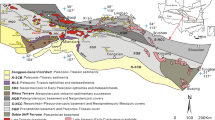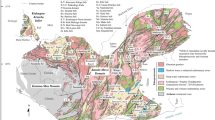Abstract
New 40Ar/39Ar data from sedimentary rock-hosted orogenic gold deposits in northeastern Tasmania constrain most ore formation to between 395 Ma and 385 Ma. These 385–395 Ma ages for the formation of orogenic gold agree well with an inferred Early to Middle Devonian timing for peak deformation and folding across much of northeastern Tasmania. Data from micas within alteration halos in some deposits give dates of ~420–430 Ma; these dates confirm the occurrence of an earlier Silurian phase of deformation and suggest that at least some of the mineralisation was possibly generated during this event. Gold mineralisation hosted by Middle Devonian post-tectonic granites may be genetically related to magmatism following orogeny, but these deposits formed virtually synchronously with peak deformation-related systems. Early to Middle Devonian deformation in northeastern Tasmania also reactivated older structures in western Tasmania, and the formation of quartz vein-hosted gold mineralisation there. Based on geological, structural, tectonic and metallogenetic similarities, northeastern Tasmania is interpreted as a lateral equivalent of the turbidite-dominated fold-thrust belt of the western Lachlan Orogen. However, unlike Victoria, where the sedimentary rock sequence developed on oceanic crust, northeastern Tasmania was probably underlain by thinned Proterozoic crust, either as part of a promontory along the Gondwana margin or as a microcontinental fragment. This may have ‘protected’ the Palaeozoic succession from large-scale, pre-Devonian orogeny, with collision not beginning until the Middle Devonian. These variations in the structural and tectonic evolution, and the timing of deformation and ore formation can explain the difference in contained gold, and the distribution and number of major orogenic gold deposits within the Palaeozoic of northeastern Tasmania.








Similar content being viewed by others
References
Baillie PW (1985) A Palaeozoic suture in eastern Gondwanaland. Tectonics 4:653–660.
Banks MR, Smith A (1968) A graptolite from the Mathinna Beds, northeastern Tasmania. Aust J Sci 31:118–119
Berry RF, Crawford AJ (1988) The tectonic significance of Cambrian allochthonous mafic-utramafic complexes in Tasmania. Aust J Earth Sci 35:523–534
Bierlein FP, Crowe DE (2000) Phanerozoic orogenic lode gold deposits. In: Hagemann SG, Brown PE (eds), Gold in 2000, Society of Economic Geologists Reviews in Economic Geology 13. pp 103–139
Bierlein FP, Arne DC, Keay SM, McNaughton NJ (2001a) Timing relationships between felsic magmatism and mineralisation in the central Victorian Gold Province, SE Australia. Aust J Earth Sci 48:883–899
Bierlein FP, Arne DC, Foster DA, Reynolds PR (2001b) A geochronological framework for slate belt-hosted gold mineralisation in central Victoria, Australia. Miner Deposita 36:741–767
Black LP (2001) SHRIMP U-Pb dating. A. Crystallisation ages of Tasmanian granites, and their significance. The geological framework of Tasmania; symposium abstracts AGSO & MRT conference, Hobart, Australia, 13–14 June, pp 14
Black LP, Calver C, Seymour D (2004a) New constraints on age and correlation of Tasmanian Proterozoic successions from SHRIMP U-Pb detrital zircon dating. Geol Soc Aust Abst 73:55
Black LP, McClenaghan M, Korsch R, Everad J, Calver C, Seymour D, Reed A, Foudoulis C (2004b) Using SHRIMP to decipher the history of Middle Palaeozoic magmatism in Tasmania. Geol Soc Aust Abst 73:55
Bottrill RS, Huston DL, Taheri J, Zaw K (1992) Gold in Tasmania. Bull Geol Surv Tasmania 70:24–56
Cebula GT, Kunk MJ, Mehnert HH, Naeser CW, Obradovich JD, Sutter JF (1986) The fish canyon tuff, a potential standard for the 40Ar−39Ar and fission-track dating methods (abstract), Terra Cognita (sixth international conference on geochronology, cosmochronology and isotope geology) 6:139
Chappell BW, White AJR, Hine R (1988) Granite provinces and basement terranes in the Lachlan fold belt, southeastern Australia. Aust J Earth Sci 35:505–524
Cocker J (1982) Rb-Sr geochronology and Sr isoope composition of Devonian granitoids, eastern Tasmania. J Geol Soc Aust 29:139–157
Crawford AJ (1988) Cambrian. In: Douglas JG, Ferguson JA (eds), Geology of Victoria. Victorian Divison, Geological Society of Australia, pp. 36–62
Crawford AR, Campbell KS (1973) large-scale horizontal displacement within Australo-Antarctica in the Ordovician. Nature 241:11–14
Crawford AJ, Cameron WE, Keays RR (1984) The association boninite-low-Ti andesite-tholeiite in the Heathcote Greenstone Belt; ensimatic setting for the early Lachlan Fold Belt. Aust J Earth Sci 31:161–177
Di Vincenzo G, Viti C, Rocchi S (2003) The effect of chlorite interlayering on 40Ar−39Ar biotite dating: an 40Ar−39Ar laser-probe and TEM investigations of variably chloritised biotites. Contrib Mineral Petr 145: 643–658
Drummond BJ, Barton TJ, Korsch RJ, Rawlinson N, Yeates AN, Collins CDN, Brown AV (2000) Evidence for crustal extension and inversion in eastern Tasmania, Australia, during the Neoproterozoic and Early Palaeozoic. Tectonophysics 329:1–21
Elliott CG, Gray DR (1992) Correlations between Tasmania and the Tasman-Transantarctic Orogen: evidence for easterly derivation of Tasmania relative to mainland Australia. Geology 20:621–624
Fergusson CL (1987) Early Palaeozoic back-arc deformation in the Lachlan Fold Belt, southeastern Australia: implications for terrane translation n eastern Gondwanaland. In: Leitch EC, Scheibner E (eds), Terrane Accretion and Orogenic Belts. American Geophysical Union Geodynamics Series 19. pp. 39–56
Fergusson CL (2003) Ordovician-Silurian accretion tectonics of the Lachlan Fold Belt, southeastern Australia. Aust J Earth Sci 50:475–490
Foster DA, Gray DR (2000) Evolution and structure of the Lachlan Fold Belt (Orogen) of eastern Australia. Annu Rev Earth Pl Sci 28:47–80
Foster DA, Gray DR, Kwak TAP, Bucher M (1998) Chronology and orogenic framework of turbidite hosted gold deposits in the Western Lachlan Fold Belt, Victoria:40Ar/39Ar results. Ore Geol Rev 13:229–250
Foster DA, Gray DR, Bucher M (1999) Chronology of deformation within the turbidite-dominated Lachlan orogen: Implications for the tectonic evolution of eastern Australia and Gondwana. Tectonics 18:452–485
Foster DA, Gray DR, Spaggiari CV (2004) Timing of subduction and exhumation along the Cambrian East Gondwana margin, and the formation of Paleozoic back-arc basins. Bulletin of the Geological Society of America (in press).
Gray CM (1990) A strontium isotopic traverse across the granitic rocks of southeastern Australia: petrogenetic and tectonic implications. Aust J Earth Sci Bull 37:331–349
Gray DR (1997) Tectonics of the southeastern Australian Lachlan Fold Belt: structural and thermal aspects. In: Burg JP, Ford M (eds), Orogeny through time, Geological Society of London Special Publication 121, pp 149–177
Gray DR, Foster DA (1998) Character and kinematics of faults within a structurally thickened subduction-accretion system, Lachlan Fold Belt: implications for the tectonic evolution of eastern Australia. J Struct Geol 20:1691–1720
Hills PB, MacDonald G, Nero L, Mueller M (2001) Beaconsfield Gold Mine—Tasmania Reef. In: Reed AR (ed), Structure and setting of Proterozoic and Palaeozoic rocks in the Tamar region, northern Tasmania, Geological Society of Australia Specialist Group in Tectonics and Structural Geology Field Guide 9, pp 57–75
Keele R (1994) Structure and veining in the Devonian-aged Mathinna-Alberton Gold Lineament, NE Tasmania. Mineral Resources Tasmania Report 1994/06
Lanphere MA, Dalrymple GB (1976) identification of excess 40Ar by the 40Ar/39Ar age spectrum technique. Earth Planet Sci Lett 32: 141–148
Lister GS, Etheridge MA, Symonds PA (1991) Detachment models for the formation of passive continental margins. Tectonics 10: 1038–1064
MacDonald G, Hills PB, Reed AR, Zengerer M, Morrison KC, Roach M (2001) Beaconsfield region. In: Reed AR (ed), Structure and setting of Proterozoic and Palaeozoic rocks in the Tamar region, northern Tasmania, Geological Society of Australia Specialist Group in Tectonics and Structural Geology Field Guide 9, pp. 25–42
McClenaghan MP (2001) The geochemistry of Tasmanian Devonian-Carboniferous granites and implications for the composition of their source rocks. The geological framework of Tasmania; symposium abstracts AGSO & MRT Conference, Hobart, Australia, 13–14 June, p 17
McClenaghan MP, Higgins N (1993) The age and intrusive relationships of granitoids of the Blue Tier Batholith, NE Tasmania. Mineral Resources Tasmania report 1993/33
McDougall I, Harrison TM (1988) Geochronology and thermochronology by the 40Ar/39Ar method. Monograph No 9, Oxford University Press, Oxford, pp. 212
Meffre S, Berry RF, Hall M (2000) Cambrian metamorphic complexes in Tasmania: tectonic implications. Aust J Earth Sci 47:971–985
Mineral Resources Tasmania (2001) Mineral exploration opportunities in Tasmania—a summary of opportunities for mineral exploration and mineral resource development in Tasmania. Department of Infrastructure, Energy and Resources, Rosny Park, Tasmania, pp 24
Offler R, McKnight SW, Morand V (1998) Tectono-thermal history of the western Lachlan Fold Belt—insights from white mica studies. J Metamorph Geol 16:529–535
Patison NL, Berry RF, Davidson GJ, Taylor BP, Bottrill RS, Manzi B, Ryba J, Shepherd RE (2001) Regional metamorphism of the Mathinna Group, northeast Tasmania. Aust J Earth Sci 48:281–292
Powell CMcA., Baillie PW (1992) Tectonic affinity of the Mathinna Group in the Lachlan Fold Belt. Tectonophysics 214:193–209
Powell CMcA, Baillie PW, VandenBerg AHM (2003) Silurian to mid-Devonian basin development of the Melbourne Zone, Lachlan Fold Belt, southeastern Australia. Tectonophysics 375:9–36
Ramsay WHR, Bierlein FP, Arne DC, VandenBerg AHM (1998) A review of turbidite-hosted gold deposits, Central Victoria: regional setting, styles of mineralisation and genetic constraints. Ore Geol Rev 13:131–151
Reed AR (2001a) Pre-Tabberabberan deformation in eastern Tasmania: a southern extension of the Benambran Orogeny. Aust J Earth Sci 48:785–796
Reed AR (2001b) Increasing gold prospectivity in the west Tamar region, northern Tasmania. The geological framework of Tasmania; symposium abstracts AGSO & MRT conference, Hobart, Australia, 13–14 June 2001, p 11
Reed AR (2002) Formation of lode-style gold mineralisation during Tabberabberan wrench faulting at Lefroy, eastern Tasmania. Aust J Earth Sci 49:879–890
Rickards RB, Davidson G, Banks MR (1993) Silurian (Ludlow) graptolites from Golden Ridge, NE Tasmania. Assoc Australasian Palaeontol Memoir 15:125–135
Rickards RB, Hills PB, Banks MR, MacDonald G (2002) A new discovery of Monograptus thomasi (Early Devonian) southwest of Beaconsfield, Tasmania, and its significance. Pap Proc Roy Soc Tasmania 136:7–16
Roach MJ (1992) Geology and geophysics of the Lisle- Golconda goldfield, northeast Tasmania. Bull Geol Surv Tasmania 70:189–198
Russell DW, van Moort JC (1992) Mineralogy and stable isotope geochemistry of the Beaconsfield, Salisbury and Lefroy goldfields. Bull Geol Surv Tasmania 70:208–226
Smith AG, Hallam A (1970) The fit of the southern continents. Nature 225:139–144
Spaggiari CV, Gray DR, Foster DA, McKnight S (2003) Evolution of the boundary between the western and central Lachlan orogen: implication for Tasmanide tectonics. Aust J Earth Sci 50:725–750
Spaggiari CV, Gray DR, Foster DA (2004) Ophiolite accretion in the Lachlan Orogen, southeastern Australia. J Struct Geol 26:87–112
Taheri J (1992) Northeast goldfields: a summary of the Tower Hill, Mathinna and Dans Rivulet goldfields. Mineral Resources Tasmania report 1992/10
Taheri J, Bottrill R. (1994) A study of the nature and origin of gold mineralisation, Mangana-Forester area, NE Tasmania. Mineral Resources Tasmania report 1994/05
VandenBerg AHM, Willman CE, Maher S, Simons BA, Cayley RA, Morand VJ, Taylor DH, Moore D, Radojkovic A (2000) The Tasman Fold Belt System in Victoria. Geol Surv Vic Special Publication, Melbourne, pp 462
Zurkic N (1998) Fosterville gold deposits. In: Berkman DA, Mackenzie DH (eds), Geology of Australian and Papua New Guinean Mineral Deposits. The Australasian Institute of Mining and Metallurgy Monograph 22, pp 507–510
Acknowledgements
We are grateful to P.B. Hill and G. MacDonald (Allstate Explorations), and R. Fulton (UTas) for providing access to sample locations, and numerous fruitful discussions on the topic of this study. Input from A. Reed, T. Green, R. Berry, and D. Groves helped clarify some of the ideas developed herein. D. Steele is thanked for assistance with the EM analysis of the fuchsite samples, as are M. Hartley (UFL) and T. Spell (UNLV) for their assistance with 40Ar/39Ar analysis. The manuscript benefited from insightful comments by reviewers V. Bouchot and A. Clark. F.P.B acknowledges the support of a Monash University Logan Fellowship and an Australian Research Council Discovery Grant (DP0342488). D.A.F’s research was supported by National Science Foundation grant EAR-0073638.
Author information
Authors and Affiliations
Corresponding author
Additional information
Editorial handling: V. Bouchot
Electronic Supplementary Material
ESM_Table_1.pdf
(PDF 20 KB)
Rights and permissions
About this article
Cite this article
Bierlein, F.P., Foster, D.A., Gray, D.R. et al. Timing of orogenic gold mineralisation in northeastern Tasmania: implications for the tectonic and metallogenetic evolution of Palaeozoic SE Australia. Miner Deposita 39, 890–903 (2005). https://doi.org/10.1007/s00126-004-0458-4
Received:
Accepted:
Published:
Issue Date:
DOI: https://doi.org/10.1007/s00126-004-0458-4




